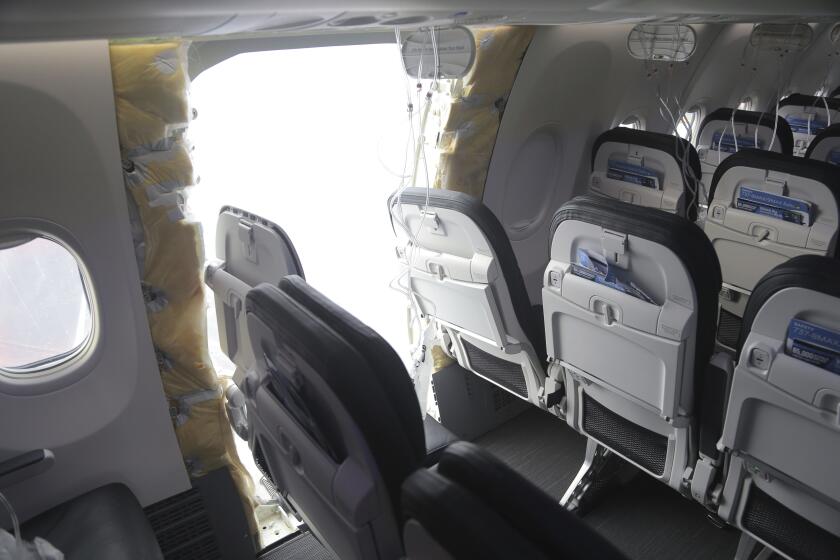DOJ opens criminal investigation into the Alaska Airlines 737 plane blowout, report says

- Share via
SEATTLE — The Department of Justice has launched a criminal investigation into the Boeing jetliner blowout that left a gaping hole on an Alaska Airlines plane in January, the Wall Street Journal reported Saturday.
Citing documents and people familiar with the matter, the newspaper said investigators have contacted some passengers and crew — including pilots and flight attendants — who were on the Jan. 5 flight.
The Boeing plane used by Alaska Airlines suffered the blowout seven minutes after takeoff from Portland, Ore., forcing the pilots to make an emergency landing. Boeing has been under increased scrutiny since the incident, when a panel that plugged a space left for an extra emergency door blew off a Max 9 jet. There were no serious injuries.
“In an event like this, it’s normal for the DOJ to be conducting an investigation,” Alaska Airlines said in a prepared statement. “We are fully cooperating and do not believe we are a target of the investigation.”
Boeing declined to comment. The Justice Department did not immediately reply to a request for comment.
The FAA says it will audit Boeing’s aircraft production and increase oversight of the company after a blowout aboard an Alaska Airlines flight.
The Journal reported that the investigation would assist the department’s review of whether Boeing complied with a previous settlement that resolved a federal investigation into the safety of its 737 Max aircraft after two deadly crashes in 2018 and 2019.
In 2021, Boeing had agreed to pay $2.5 billion, including a $244-million fine, to settle an investigation into the crashes of flights operated by Lion Air and Ethiopian Airlines. The company also blamed two employees for deceiving regulators about flaws in the flight-control system.
Boeing has acknowledged in a letter to Congress that it cannot find records for work done on the door panel of the Alaska Airlines plane.
“We have looked extensively and have not found any such documentation,” Ziad Ojakli, Boeing executive vice president and chief government lobbyist, wrote to Sen. Maria Cantwell (D-Wash.) on Friday.
The company said its “working hypothesis” was that the records about the panel’s removal and reinstallation on the 737 Max final assembly line in Renton, Wash., were never created, even though Boeing’s systems required it.
The letter, reported earlier by the Seattle Times, followed a contentious Senate committee hearing Wednesday in which Boeing and the National Transportation Safety Board argued over whether the company had cooperated with investigators.
The safety board’s chair, Jennifer Homendy, testified that for two months Boeing repeatedly refused to identify employees who work on door panels on Boeing 737s and failed to provide documentation about a repair job that included removing and reinstalling the door panel.
“It’s absurd that two months later we don’t have that,” Homendy said. “Without that information, that raises concerns about quality assurance, quality management, safety management systems” at Boeing.
Cantwell demanded a response from Boeing within 48 hours.
Shortly after the Senate hearing, Boeing said it had given the NTSB the names of all employees who work on 737 doors — and had previously shared some of them with investigators.
In the letter, Boeing said it had already made clear to the safety board that it couldn’t find the documentation. Until the hearing, it said, “Boeing was not aware of any complaints or concerns about a lack of collaboration.”
In a preliminary report last month, the NTSB said four bolts that help keep the door plug in place were missing after the panel was removed so workers could repair nearby damaged rivets last September. The rivet repairs were done by contractors working for Boeing supplier Spirit AeroSystems, but the NTSB still does not know who removed and replaced the door panel, Homendy said Wednesday.
The Federal Aviation Administration recently gave Boeing 90 days to say how it will respond to quality-control issues raised by the agency and a panel of industry and government experts. The panel found problems in Boeing’s safety culture despite improvements made after two Max 8 jets crashed in 2018 and 2019, killing 346 people.
Johnson writes for the Associated Press.
More to Read
Sign up for Essential California
The most important California stories and recommendations in your inbox every morning.
You may occasionally receive promotional content from the Los Angeles Times.














